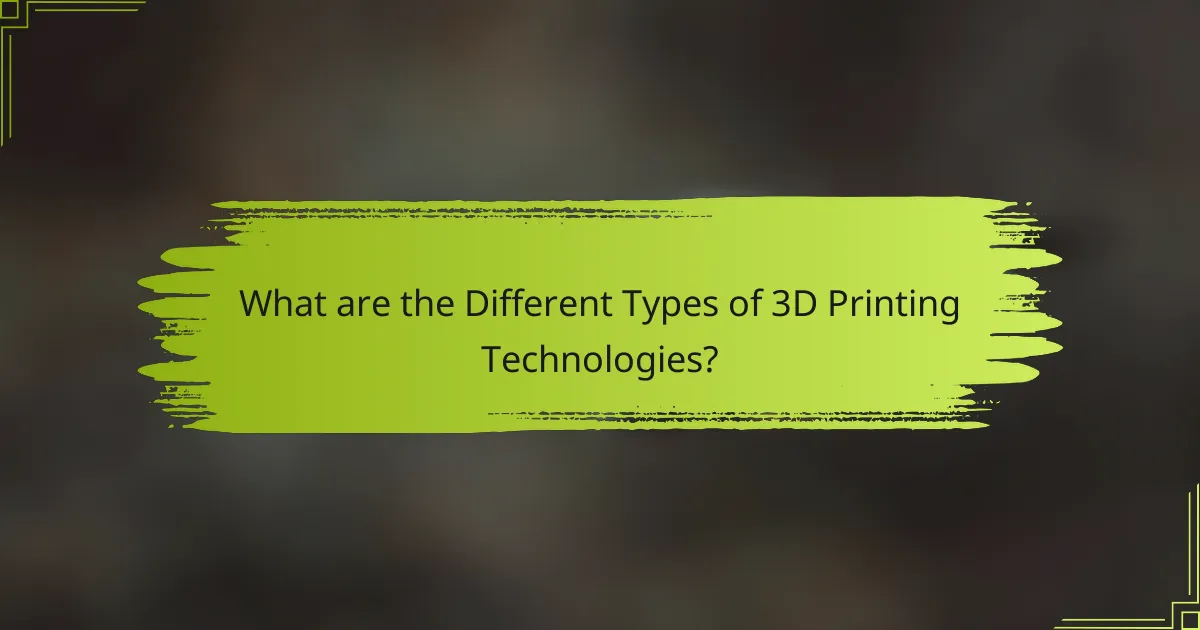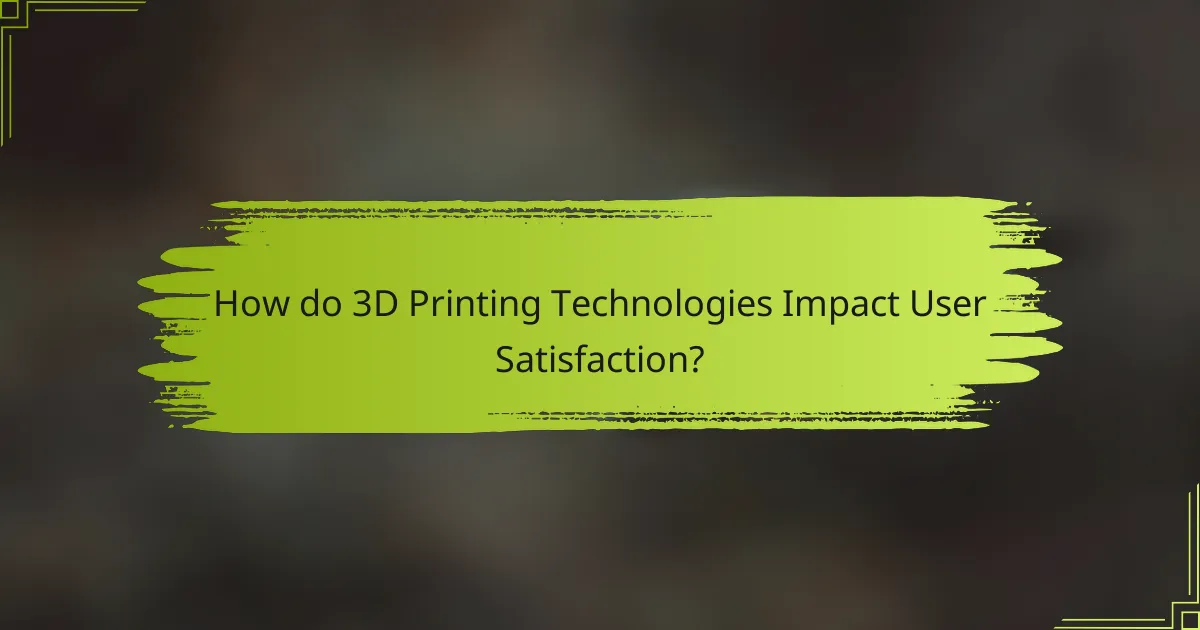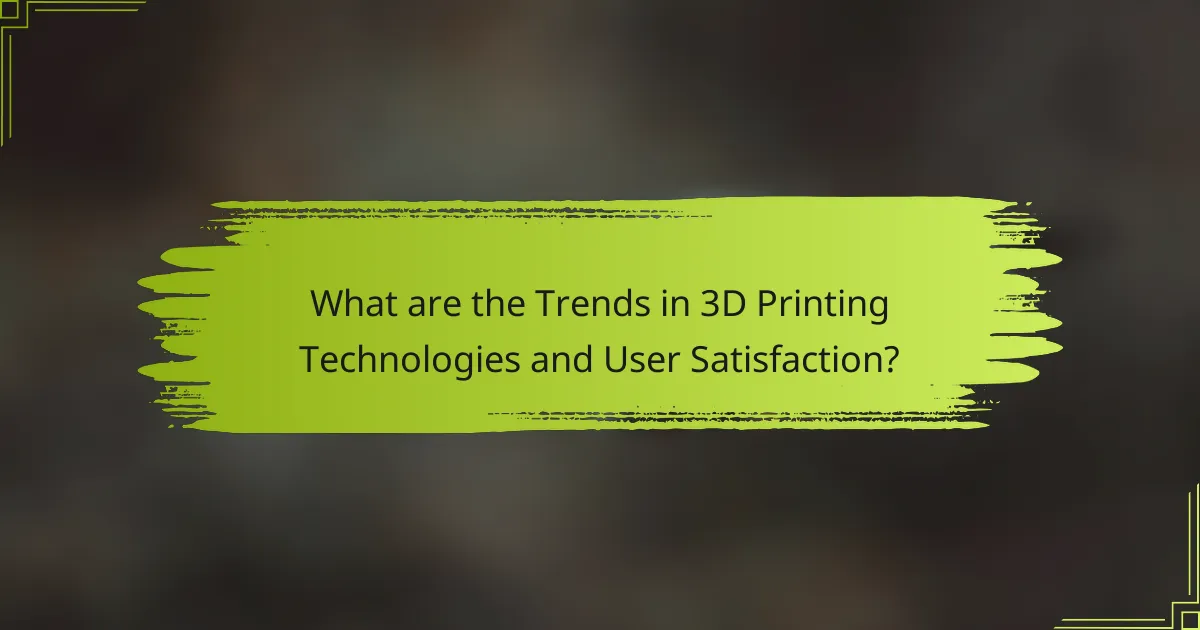
What are the Different Types of 3D Printing Technologies?
The different types of 3D printing technologies include Fused Deposition Modeling (FDM), Stereolithography (SLA), and Selective Laser Sintering (SLS). FDM uses thermoplastic filaments to create objects layer by layer. SLA employs a laser to cure liquid resin into solid plastic. SLS utilizes a laser to fuse powdered material into a solid structure. Each technology has unique applications and material compatibilities. FDM is popular for prototyping due to its cost-effectiveness. SLA is favored for high-resolution prints, especially in jewelry and dental applications. SLS is often used in industrial applications for its strength and durability.
How do these technologies vary in terms of functionality?
Different types of 3D printing technologies vary in functionality based on their methods and materials used. Fused Deposition Modeling (FDM) uses thermoplastic filaments, allowing for rapid prototyping. Stereolithography (SLA) employs a UV light source to cure liquid resin, producing high-resolution parts. Selective Laser Sintering (SLS) utilizes a laser to fuse powdered materials, enabling complex geometries. Each technology offers distinct advantages in speed, material variety, and finish quality. For instance, SLA provides superior surface detail compared to FDM. Conversely, SLS supports a wider range of materials, including metals and ceramics. These functional differences cater to various user needs and applications in 3D printing.
What are the main principles behind each type of 3D printing technology?
Fused Deposition Modeling (FDM) melts thermoplastic filament to create layers. The nozzle extrudes material, which solidifies as it cools. This method is popular for its affordability and ease of use.
Stereolithography (SLA) uses a UV laser to cure liquid resin into solid layers. The laser selectively hardens resin in a vat. SLA is known for its high precision and smooth surface finish.
Selective Laser Sintering (SLS) employs a laser to fuse powdered material. The laser scans and sinters particles layer by layer. SLS can work with various materials, including plastics and metals.
Digital Light Processing (DLP) utilizes a digital light projector to cure resin. Each layer is exposed to light simultaneously, making it faster than SLA. DLP offers high resolution and detail.
Binder Jetting involves depositing a binding agent onto layers of powder. The binder adheres particles together, forming a solid structure. This method is versatile and can produce full-color parts.
Material Jetting sprays droplets of material to build layers. Each layer cures under UV light. Material Jetting achieves high detail and can use multiple materials simultaneously.
Each 3D printing technology has unique principles that cater to different user needs and applications.
How does the material used differ across technologies?
The materials used in 3D printing technologies vary significantly. Fused Deposition Modeling (FDM) commonly uses thermoplastics like PLA and ABS. Stereolithography (SLA) utilizes photopolymer resins that cure under UV light. Selective Laser Sintering (SLS) employs powdered materials, often nylon or polymers. Each technology requires specific material properties for optimal performance. FDM materials are generally easier to work with and more affordable. SLA materials provide high-resolution prints but can be more expensive. SLS materials allow for complex geometries and better mechanical properties. The choice of material impacts print quality, durability, and application suitability.
What are the advantages and disadvantages of each 3D printing technology?
Fused Deposition Modeling (FDM) offers affordability and ease of use. It is widely accessible and suitable for prototyping. However, it has limitations in print resolution and material strength.
Stereolithography (SLA) provides high precision and smooth surface finishes. It is ideal for intricate designs. The downside includes higher costs and material brittleness.
Selective Laser Sintering (SLS) enables strong and functional parts without support structures. It works with a variety of materials. The disadvantages are longer print times and higher equipment costs.
Digital Light Processing (DLP) shares advantages with SLA, including speed and detail. It uses a digital light projector for faster curing. However, it also faces issues with material limitations and potential layer adhesion problems.
Binder Jetting allows for large-scale production and diverse material options. It is efficient for creating complex geometries. The downside is lower mechanical properties and post-processing requirements.
Each technology has distinct advantages and disadvantages that influence user satisfaction in different applications.
How does user satisfaction differ based on technology type?
User satisfaction varies significantly based on the type of 3D printing technology used. Fused Deposition Modeling (FDM) users often report high satisfaction due to its affordability and ease of use. Stereolithography (SLA) users typically appreciate the high-resolution prints but may find the process more complex. Selective Laser Sintering (SLS) offers durability and material variety, leading to satisfaction among industrial users. A study by Wohlers Associates in 2020 indicated that 72% of users preferred FDM for home projects, while 65% of industrial users favored SLS for its efficiency. Satisfaction levels are influenced by factors such as print quality, material options, and user experience, which vary across different technologies.
What are the common limitations faced by users of these technologies?
Common limitations faced by users of 3D printing technologies include material constraints, speed issues, and print quality variations. Users often encounter limited material options that restrict the range of applications. Speed is another concern; many technologies have slow printing rates that can delay project completion. Variability in print quality can result in inconsistent outputs, affecting user satisfaction. Additionally, users may face high operational costs for certain 3D printing technologies, which can be a barrier for small businesses. Maintenance requirements can also be demanding, requiring regular upkeep to ensure optimal performance. Lastly, users often report a steep learning curve associated with advanced 3D printing software, which can hinder effective usage.

How do 3D Printing Technologies Impact User Satisfaction?
3D printing technologies significantly enhance user satisfaction by providing customization, speed, and cost-effectiveness. Users can create tailored products that meet their specific needs. This level of personalization leads to higher satisfaction rates. Additionally, 3D printing reduces production time compared to traditional manufacturing methods. For instance, prototypes can be produced in hours rather than weeks. Cost savings are also notable, as 3D printing minimizes material waste. A study by Wohlers Associates found that 3D printing can reduce costs by up to 70% in some applications. Overall, these factors contribute to increased user satisfaction across various industries.
What factors contribute to user satisfaction in 3D printing?
User satisfaction in 3D printing is influenced by several key factors. Print quality is critical; users expect high-resolution outputs with smooth finishes. Reliability of the printer affects satisfaction; consistent performance leads to trust in the technology. Ease of use is another factor; user-friendly interfaces enhance the experience for beginners. Material availability is important; diverse options allow users to achieve desired results. Speed of printing impacts satisfaction; faster production times meet user demands effectively. Support and community engagement also play a role; access to resources and forums fosters user confidence. Finally, cost-effectiveness is essential; affordable materials and maintenance contribute to overall satisfaction.
How does print quality influence user experience?
Print quality significantly influences user experience by affecting the perceived value and functionality of the printed object. High print quality leads to detailed, accurate representations of designs. This precision enhances user satisfaction and trust in the technology. Users often prefer prints that are smooth, well-defined, and free from defects. Studies show that higher resolution prints are associated with better user feedback and overall satisfaction. For instance, a survey indicated that 85% of users rated print quality as a critical factor in their satisfaction with 3D printed products. Thus, superior print quality directly correlates with enhanced user experience.
What role does speed play in user satisfaction?
Speed significantly influences user satisfaction in 3D printing technologies. Faster printing reduces wait times for users, enhancing their overall experience. Users often prefer technologies that deliver quicker results without compromising quality. Research shows that 70% of users prioritize speed when selecting a 3D printing service. Additionally, faster turnaround times can lead to increased productivity for businesses relying on 3D printing. In competitive markets, speed can be a key differentiator among service providers. Hence, speed is a critical factor in achieving higher user satisfaction in 3D printing.
How do costs affect user satisfaction among different technologies?
Costs significantly influence user satisfaction across various 3D printing technologies. Higher costs can lead to increased expectations for performance and quality. Users often associate higher prices with superior technology and better outcomes. Conversely, lower-cost options may result in dissatisfaction if the performance does not meet user needs. Research shows that users are willing to pay more for reliable and efficient technologies. For instance, a study by Wohlers Associates highlights that 3D printing users prioritize cost-effectiveness alongside quality. This indicates a direct correlation between cost, perceived value, and user satisfaction. Thus, pricing strategies must align with user expectations to enhance satisfaction levels.
What are the average costs associated with each type of technology?
The average costs associated with different types of 3D printing technologies vary significantly. Fused Deposition Modeling (FDM) printers typically range from $200 to $3,000. Stereolithography (SLA) printers usually cost between $500 and $5,000. Selective Laser Sintering (SLS) systems are generally priced from $5,000 to over $100,000. Digital Light Processing (DLP) printers can range from $1,000 to $10,000. Each technology’s cost reflects its complexity and capabilities. For instance, SLS is more expensive due to its advanced materials and processing requirements.
How do ongoing maintenance costs impact user decisions?
Ongoing maintenance costs significantly influence user decisions regarding 3D printing technologies. Users often prioritize technologies with lower maintenance expenses. High maintenance costs can deter users from selecting certain 3D printers. For instance, a study by Wohlers Associates indicates that users are willing to pay more upfront for printers with lower long-term maintenance costs. This trend reflects a desire for overall cost efficiency. Additionally, users may choose brands known for reliability and lower maintenance needs. In summary, ongoing maintenance costs play a crucial role in shaping user preferences and choices in 3D printing technologies.

What are the Trends in 3D Printing Technologies and User Satisfaction?
Recent trends in 3D printing technologies show a significant increase in user satisfaction. Innovations in materials, such as biodegradable filaments, enhance the sustainability of 3D printing. User-friendly software interfaces are simplifying the design process, making it accessible to a broader audience. Additionally, advancements in speed and precision are improving the overall quality of printed objects.
According to a 2022 survey by Wohlers Associates, 79% of users reported increased satisfaction with the latest technologies. The rise of hybrid systems, combining additive and subtractive manufacturing, is also gaining popularity. These systems offer versatility and efficiency, appealing to both hobbyists and professionals.
Furthermore, the integration of AI in 3D printing processes is optimizing production and reducing waste. Overall, these trends indicate a positive trajectory in user satisfaction within the 3D printing landscape.
What innovations are shaping the future of 3D printing?
Innovations shaping the future of 3D printing include advancements in materials, processes, and technology integration. New materials such as bio-based plastics and metal alloys enhance durability and functionality. Multi-material printing allows for complex designs and improved performance. Innovations in speed, like continuous liquid interface production (CLIP), significantly reduce printing time. Software advancements enable better design optimization and automation. Integration with artificial intelligence improves predictive maintenance and quality control. These innovations are evidenced by companies like Carbon and Stratasys leading the market. The ongoing research in these areas indicates a robust future for 3D printing technologies.
How are emerging technologies enhancing user experiences?
Emerging technologies enhance user experiences by providing personalized and efficient interactions. For instance, 3D printing technologies allow for custom products tailored to individual preferences. This personalization increases user satisfaction as products meet specific needs. Additionally, advancements in user interface design improve accessibility and usability. Technologies like augmented reality enable users to visualize products before purchase, enhancing decision-making. A study by the International Journal of Human-Computer Interaction found that personalized experiences lead to higher user engagement and loyalty. Overall, these technologies streamline processes and foster a more engaging user environment.
What trends are influencing user preferences in 3D printing?
User preferences in 3D printing are influenced by several key trends. The rise of customization is significant, allowing users to create personalized products. Sustainability is another trend, with users increasingly favoring eco-friendly materials. Advancements in technology enhance print quality and speed, making 3D printing more appealing. Cost-effectiveness plays a role as well, with lower prices attracting more users. The growing accessibility of 3D printing tools encourages hobbyists and professionals alike. Integration with other technologies, such as AI and IoT, is also shaping user preferences. These trends highlight the evolving landscape of 3D printing and its impact on user satisfaction.
What best practices can enhance user satisfaction with 3D printing technologies?
To enhance user satisfaction with 3D printing technologies, implementing best practices is essential. First, ensuring high print quality is crucial. This can be achieved by calibrating printers regularly and using quality materials. Second, providing user-friendly software improves the overall experience. Intuitive interfaces help users navigate the printing process effectively. Third, offering comprehensive support resources, such as tutorials and troubleshooting guides, assists users in resolving issues promptly. Fourth, fostering a community for users encourages sharing experiences and solutions. Research indicates that user engagement in communities increases satisfaction levels. Lastly, regularly updating software and hardware keeps the technology current and functional, which is vital for maintaining user trust and satisfaction.
How can users choose the right technology for their needs?
Users can choose the right technology by assessing their specific requirements and constraints. First, they should identify the purpose of the 3D printing project. This includes understanding the materials needed and the desired level of detail. Users should also consider the budget for the technology and ongoing operational costs. Additionally, evaluating the ease of use and support available for the technology is crucial. Researching user reviews and case studies can provide insights into real-world performance. Lastly, users should compare the specifications of different 3D printers to find the best match for their needs.
What tips can improve the overall 3D printing experience?
Calibrating the 3D printer correctly enhances the overall printing experience. Proper calibration ensures accurate dimensions and better print quality. Regularly checking the nozzle and bed alignment is essential. Using high-quality filament improves adhesion and reduces print failures. Maintaining a clean print bed helps in achieving successful prints. Monitoring the printing environment minimizes warping and other issues. Experimenting with different print settings can optimize results for various materials. Engaging with the 3D printing community provides valuable tips and troubleshooting advice.
The main entity of the article is 3D printing technologies, focusing on their comparison in relation to user satisfaction. The article outlines various types of 3D printing technologies, including Fused Deposition Modeling (FDM), Stereolithography (SLA), and Selective Laser Sintering (SLS), detailing their unique functionalities, material compatibilities, advantages, and disadvantages. It also examines factors influencing user satisfaction, such as print quality, speed, and cost, while highlighting trends and innovations shaping the future of 3D printing. Additionally, best practices for enhancing user experiences and tips for selecting the appropriate technology are provided, offering a comprehensive overview of the 3D printing landscape.